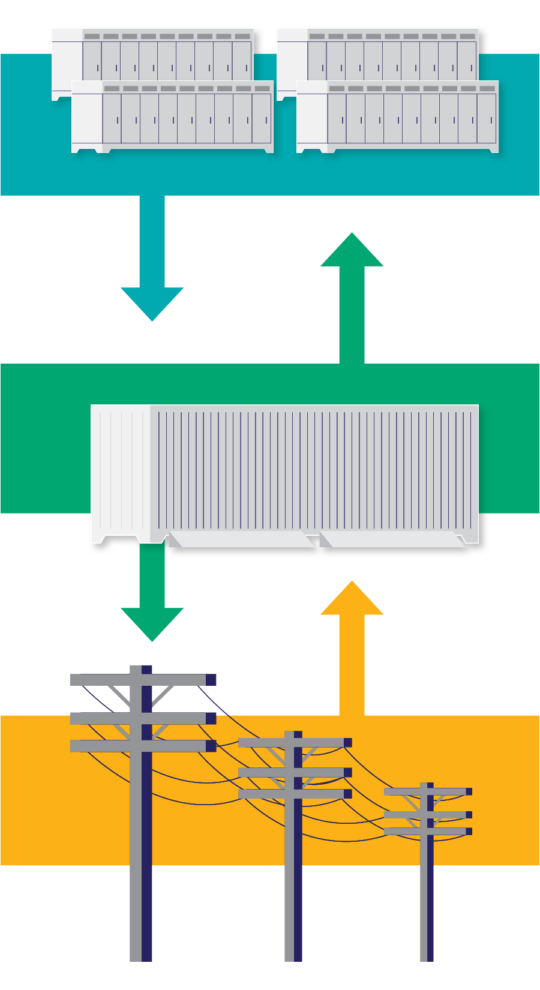
Cypress Creek Renewables: Committed to a Better, Cleaner World
Cypress Creek Renewables is powering a sustainable future, one project at a time. We develop, finance, own, and operate renewable energy projects across the nation. Since 2014, we have developed 12 gigawatts of renewable energy, enough to power 4.8 million homes, including approximately 75 projects in the Northeast alone.
We have a rich history of partnering and collaborating with municipalities, residents, civic organizations, environmental advocates, businesses, and others to ensure that our projects are responsive to the needs of each community we serve.
About Kalmia Energy Storage
Kalmia Storage is a proposed 50-megawatt battery energy storage system. The project is located in the hamlet of Holtsville in the town Brookhaven, New York and will connect to the Holtsville 69kV substation. The project is sited on industrially-zoned land, on which battery storage is an as-of-right use.
The project is expected to be be operational by 2030, and will provide enough energy for approximately 20,000 New York homes for 4-hours, supporting local and regional needs.
Why This Location?
New York has ambitious climate goals, targeting a 100% reduction in power grid emissions by 2040. To meet that objective, energy storage must be part of the solution. High and growing demand for power in the region supports the need for local energy infrastructure to ensure reliability today and prepare for the power grid of tomorrow. The proposed site meets key considerations such as flat topography, proximity to electrical infrastructure, and minimal projected impact on native habitats, wetlands, or other environmental features. Additionally, it is industrially zoned and has a history of commercial and industrial use.
Battery Storage: An Old Idea With a Modern Twist
We have long relied on batteries to deliver power when other sources were unavailable. Today, batteries are so integrated into our daily lives that we have become unaware of our reliance on stored energy. Yet, whenever we power up our laptop at our local cafe or call a friend to catch up, we count on batteries to do the job.
Energy storage systems harness this same general type of technology but on a greater scale. Rows of small lithium-ion batteries are placed into larger capsules called modules. These modules are subsequently stacked inside larger container units and connected to the existing electric grid.
Once operational, the energy storage system charges during times of energy abundance, storing power and releasing it back onto the electric grid during times of high demand, helping to ensure that power is available for residents and businesses when needed most.
How a Battery Storage System Works

Operation and Use of a Battery Energy Storage System (BESS)
Battery energy storage systems efficiently and conveniently capture electricity so that it can be used when it’s most needed.
Battery Units
A grid-connected battery storage system consists of batteries, racks for the batteries, communications equipment, and safety features.
Power Conversion System (PCS)
Includes inverters that convert DC energy to AC energy and communications equipment that allow the system to be monitored 24/7.
Power Grid
Power Grid where electrons can be charged and discharged adding reliability and resiliency to your local power grid and community.
Quick Facts
Creating Job Opportunities in Suffolk County
Kalmia Storage is estimated to create 60 local construction-related jobs for a period of around 18 months. These positions will create approximately $15 million in wages and benefits for local workers over the course of their employment.
Creating Benefits for Brookhaven
Kalmia Storage will deliver millions in total combined economic investment over the project’s lifetime. This additional funding can play an important role in helping support local and regional priorities.
Helping to Keep the Lights On and Costs Lower
Kalmia Storage will provide the ability to capture energy in times of abundance for use in times of high demand and scarcity, making the electric grid more reliable, resilient, and flexible while reducing costly and inconvenient power losses. Since batteries charge when energy is most available and, therefore, generally cheaper, storage projects also promote lower long-term energy costs. These savings are reflected in the wholesale energy market and can be passed along to consumers. At the same time, battery projects also help mitigate short-term energy spikes that arise during peak demand by releasing energy back onto the grid when the energy supply is low and, more generally, by increasing the overall supply of available energy on the electric grid.
More Information
A key part of New York's energy future
Kalmia Storage supports the transition to a clean energy future by maximizing the utility of intermittent renewable resources like wind and solar, facilitating their long-term integration, and providing a path to a reliable, clean power grid.
Our Good Neighbor Commitment
Kalmia Storage will put little strain on existing community resources, create no significant traffic during operation, and generate neither ground nor air pollution during normal operations. In the unlikely event of a battery fire, potential impacts remain highly localized.
As a condition of permit approval, energy storage projects must undergo rigorous scrutiny to ensure that any impact on wetlands, native species, or other environmental considerations are avoided, minimized, or mitigated.
Energy storage facilities also have relatively low height profiles and are not easily visible from most locations.
Kalmia Storage is committed to being a good neighbor to Brookhaven and has provided scholarships and community investments for the community since 2023.
Our Commitment to Safety
Battery energy storage facilities, like Kalmia Storage, must undergo rigorous safety testing and be equipped with a range of state-of-the-art technology to prevent, mitigate, and respond to potential fire safety incidents.
Safety technology includes smoke, gas, and fire detectors; internal cooling systems; fire suppression systems; ventilation systems; deflagration panels; auxiliary power; waterproof containers; and remote monitoring and shutdown capabilities.
Where incidents have occurred in the U.S., there have been no reported injuries outside the facility boundaries. Emissions dissipate quickly over short distances and are unlikely to extend more than 100 feet under normal weather conditions.
Cypress Creek exclusively sources batteries from Tier 1 suppliers with the best safety track records. Detailed Emergency Response Plans are developed before the first shovel hits the ground, and local first responders receive site-specific training. Technicians visit the site on a regular basis for maintenance and safety checks, and we provide municipalities with a dedicated fire safety support contract.
Held to nationally recognized standards
Energy storage systems are considered critical electrical infrastructure and are held to standards such as the National Fire Protection Association’s Standard 855 and numerous Underwriter Laboratories (UL) standards, including 9540A testing and Standard 9540 manufacturing standards for Energy Storage Systems. They also must comply with the 2021 International Fire Code and the U.S. National Electric Code.
Scholarship Program
As part of our good neighbor commitment, we look for new ways to positively impact the communities where we developed renewable energy projects while also preparing the next generation of workers for jobs in STEM-related fields.
- Started in 2023, Cypress Creek provides annual scholarships to high school seniors across the country.
- Suffolk County has been home to scholarship winners in 2023 and 2024, including a senior at Sachem East High School
Visit www.ccrenew.com/scholarships for more information and to apply.

Our Team
Eva Raczkowski
Project Developer

Will O’Leary
Senior Project Developer

We Want to Hear From You!
We believe the best projects come from working with the local community to meet each community’s unique needs. We are dedicated to addressing your questions and making good-faith efforts to resolve points of concern. Please complete the form below to sign up for project updates, submit a question, provide project feedback, or agree to add your name to our list of project supporters!
We strive to respond to all messages within two business days.